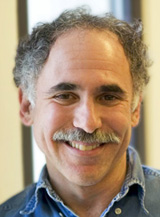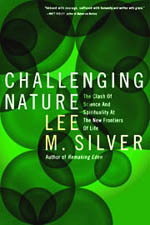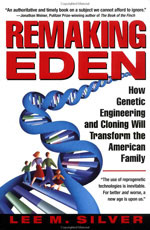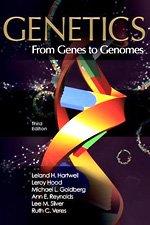|
published by Ecco/Harper Collins, 2006
|
|
Books
Presentations
Publications/Writings
Biography
Princeton Courses
|
Dear Professors Lee and George,
Thank you for responding to my recent letter, which took issue with points raised in your earlier NRO review of my book Challenging Nature. In your response, you continue to insist absolutely-- as you have in numerous articles published on this topic -- that a human embryo is a human being, while other clumps of human cells are something entirely different. Rather than continuing to debate this claim in prose, it is useful to take a more visual approach, as illustrated by comparing the two pictures below. Both show color-enhanced scanning electron micrographs of clumps of human cells. But before they were frozen for microscopy, one clump was a normal embryo, while the other was a bunch of embryonic stem cells. According to your logic, one clump was a human being, while the other was just a confined group of proteins, DNA, and other molecules. So tell me, which one is which.
Perhaps you can't tell the difference by external appearance alone (I certainly can't). But even if you could look inside with the finest microscope, it almost certainly wouldn't help because there is almost certainly no molecule, or combination of molecules, whose presence or absence distinguishes all human embryos from embryonic stem cells. At this point, you may retreat to your previous claim that only the real human embryo has "the epigenetic primordia for a functioning brain and nervous system." I haven't a clue what the term "epigenetic primordia" means since it has not been used (as far as I know) by any scientist in any of the hundreds of thousands of basic biological research articles published over the last decade.
I know this little exercise won't change your mind; I present it simply for the benefit of more open-minded NRO readers. Indeed, it is pointless to debate scientific details when even simple words like "life" and "death" are interpreted by you in ways that are foreign to most practicing biologists. So instead, I would like to put to the test your 'argument from authority' claim, which holds that the embryo-is-a-human-being proposition "is a fact confirmed by contemporary embryology and attested to by the standard works in the field." In fact, none of the standard texts you've quoted -- or any other prominent biology textbook used at major nonsectarian universities -- actually states that an "embryo" is a "human being?" (It won't do to pretend that biologists use the term "human life" as a standard synonym for "human being." Human cells growing and dividing indefinitely in petri dishes are fully alive -- in biological terms -- and fully human in their constituent parts, and yet you yourselves do not consider them to be human beings.) Furthermore, if the embryo-is-a-human-being proposition really is "confirmed by contemporary embryology," you might expect at least one of the 52 active professors in the two biology departments at the esteemed university where Professor George and I teach to acknowledge this supposedly confirmed "fact." I challenge Professor George to identify one -- just one -- Princeton biology professor who shares this viewpoint. (As an incentive, if you can come up with one name, I will buy you both a case of wine from the same vineyard that produced the delightful bottle I shared with Professor George at a pleasant dinner some years ago.)
If your search for like-minded Princeton biologists comes up empty-handed, you might argue that the liberal or libertarian milieu of Ivy League science faculties discourages professors from expressing any truly-held conservative views. But, in fact, many unabashed, culturally conservative academics simply don't agree with you either. One who takes exception is University of Chicago professor Leon Kass, the former chairman of President Bush's Council on Bioethics, on which Professor George also sits. Kass has written, "I myself would agree that a blastocyst [an embryo that is 4 to 9 days post-fertilization] is not, in a full sense, a human being." (Toward a More Natural Science, p.104). Not only is Professor Kass an accomplished scholar in the area of bioethics, he also holds both a medical degree and a Harvard Ph.D. in biochemistry. I assume, Professor George, that you've had many chances to persuade Professor Kass with your "careful argumentation and the presentation of the relevant biological facts," and (as far as I can tell), you haven't succeeded. Indeed, from my admittedly subjective point of view, it seems that most academic biologists, most nonsectarian bioethicists, most physicians, and most university-educated conservatives (forget about liberals and libertarians) don't agree with you. So what gives. Are they all stupid, ignorant, or disingenuous?
As I stated in my previous letter, there is nothing -- no fact or concept -- that will ever make you budge from your belief in the unassailable truth of the view that an embryo is a human being. It is this form of absolutism that led me to brand you as fundamentalists, mocked in the title of your original book review. However, since I was not raised or educated in a strictly religious tradition, you could argue that I don't really understand the difference between fundamentalists and non-fundamentalists. But there's no need to take my word for it because the self-described practicing-Catholic and conservative pundit Andrew Sullivan reaches exactly the same conclusion about Professor George in his hard-hitting new book, "The Conservative Soul." According to Sullivan, George and others who hold his extreme views are fundamentalists. Sullivan explains that "the fundamentalist does not tolerate a diversity of views. There is one truth; and all other pretenders are threats to it, or contradict it . . . Fundamentalists assert a central core idea and then contort or distort reality in order to make it fit their model." In a world where life and death become entirely divorced from any connection to modern biological understanding, only faith remains. It is faith of a particular type, not science, that drives the belief that the embryo shown in one of the pictures above is a human being, while the other object is not. This sort of faith is not amenable to debate, which is why this will be my final word on the subject.
Best wishes,
Professor Lee M. Silver
Princeton University
|
Hover over or click on books to order from Amazon.com
  |




